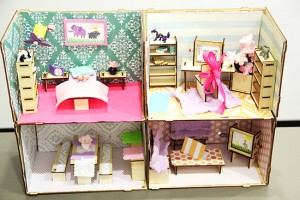A Dollhouse, Hacked
-
-
slice.mit.edu
Filed Under
Recommended
- When Alice Brooks ’10 was a child, her father gave her a saw as a gift. She used the saw to build a dollhouse, which helped spark a passion for science and engineering.
The trio traced their love of math and science to the toys that they played with as children, alongside their fathers, grandfathers, and brothers. Looking at today’s toy market for girls, they saw nothing that provoked the same interests.
The group set an ambitious goal: get young girls excited about math and science in the most fun way possible. The result: the Roominate, a STEM-infused dollhouse construction kit marketed specifically to girls ages 6–10.
Brooks told Co.Design:"We loved our dolls, stuffed animals, and Barbies growing up. But, we also loved our Legos, Lincoln Logs, Mastermind, and Chess. With Roominate, we are showing girls that they can like both. Everything is an option."

Inspired in part by Brooks’s childhood DIY dollhouse, the kit contains wooden pieces, electronic circuit components, and interior design elements with which a child can learn to build, wire, and layout her own dollhouse. Check out the video.
Call it a dollhouse, hacked.
Rooms can be side-by-side or stacked. A child can create furniture, connect circuits, and add computers, televisions, and a personal decorative touch.
And if the final product is not up to snuff—take it apart and start over.
Through Kickstarter, they raised close to $86,000—far exceeding their $25,000 goal—and sold sold more than 1,300 Roominates across six continents. There is currently a waiting list to purchase the toy, and the group plans to eventually sell the toy online and at museums, for about $65.








